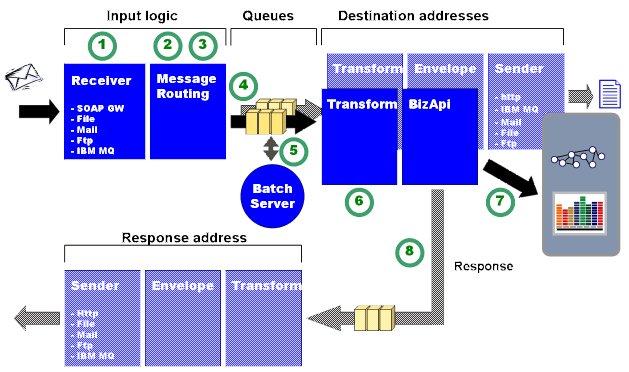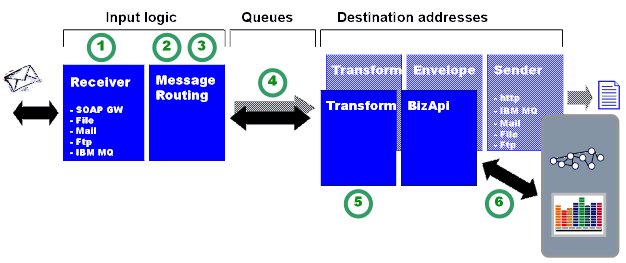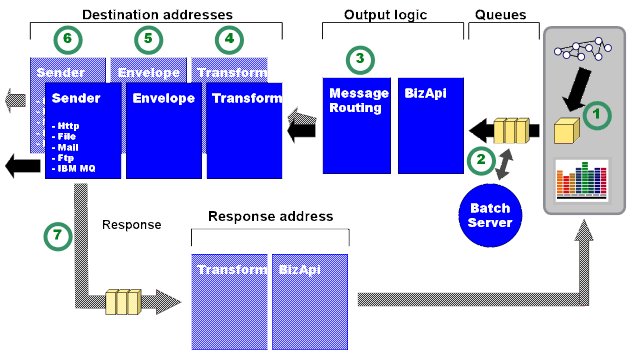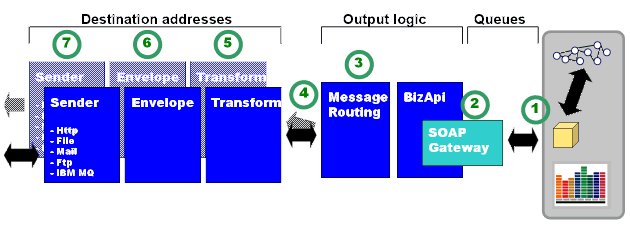BizAPI
jhmase: Overlook language and use uniform descriptions of
the different BizAPI functionality
BizAPIs are grouped by a combination of characteristics. The characteristic
categories are the Message Direction and the Protocol Type. This page aims to sort out the differences between the different types
of BizAPIs that exists in the set of valid combinations.
Contents
The first part of the BizAPI category is the message direction:
The second part of the category indicates whether the BizAPI is of the
type request/response.
- Request/response type: These are messages that have a synchronous
response returned and assumes a short-lived transaction. Examples are: CHECK_AVAILABILITY,
LIST_PRICES. These messages are always synchronous and don't use
message queues.
- Not of the request/response type: These are documents that are submitted
to an application or system. They are often part of a long-lived transaction.
Examples of this are RECEIVE_CUSTOMER_ORDER, SEND_ORDER_RESPONSE.
These messages are always asynchronous and use message queues for batch
execution.
These combinations define four different categories.

- A connector reader receives the message, calls the Message Router and
waits for a response from the queue system.
- The Message Router determines which BizAPI to invoke and if any transformer
should be applied.
- The Message Router resolves also all optional destination addresses.
- The Message Router posts the message to the IN queue and sends back a
receipt to the connect reader. If any errors occur the message is posted to
the ERROR queue instead.
- The Batch Server polls the IN queue, picks up the message and starts
execution of the destination addresses.
- The message will be transformed to IFS XML format if any transformer is
to be applied.
- The invoked BizAPI calls the actual business logic stored procedure and
sends the response back to the Batch Server. If response is ok, the message
state is changed to
FINISHED, otherwise to FAILED.
- If an optional response address is defined, the response will be
transformed (if any transformer is defined), put into a SOAP enveloped
and sent to the defined destination.

- A connect reader receives the message, calls the Message Router and
waits for a response.
- The Message Router determines which BizAPI to invoke and if any
transformers should be applied.
- The Message Router resolves all optional destination addresses.
- The Message Router executes the destination addresses and waits for a
response.
- The message will be transformed to IFS XML format if any transformer is
to be applied.
- The called BizAPI calls the actual business logic stored procedure and
returns the response back to the calling connect reader.

- The record is created by the PL/SQL Access Provider and is posted to the
OUT queue using the
Post_Outbound_BizAPI stored procedure.
- The Batch Server polls the OUT queue, picks up the record and invokes the BizAPI. Typically the record contains
only key values, thus the BizAPI fetch
the additional data from the database using the sent keys and then creates and returns the
message.
- After BizAPI execution the Message Router is called to resolve
destination addresses based on contents of the in and out data to and from
the BizAPI and also content of the record created by PL/SQL Access Provider.
- The out message will be transformed from IFS XML to any format if a
transformer is about to be applied.
- The message will be embedded into a SOAP envelope if necessary.
- The connector sends the message to the destination using its native
protocol. If response is OK, message state is changed to
FINISHED,
otherwise FAILED. Some connectors are designed to resend the
message in case of failure.
- If an optional response address is defined, the response will be
transformed (if any transformer is defined) and sent to the defined
destination.

- The record is created using the PL/SQL Access Provider and SOAP Gateway is
invoked using the
Invoke_Outbound_Request_BizAPI stored procedure of the
PL/SQL Access Provider, which then waits for a response.
- SOAP Gateway calls the corresponding outbound BizAPI.
- SOAP Gateway calls the Message Router, which determines the connector
sender(s) to run and if any transformers and/or envelope(s) should be
applied.
- The Message Router executes the destination address and waits for a
response.
- The message will be transformed, if necessary.
- The message will be embedded into an envelope, if necessary.
- The connector sender sends the message to the destination using its
native protocol. The response is returned back to the
Invoke_Outbound_Request_BizAPI procedure. Typically HTTP is
the connector sender used in this scenario.




